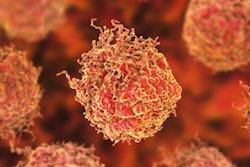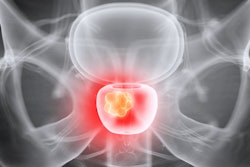
Italian researchers have created a gallium-68 (Ga-68) prostate-specific membrane antigen (PSMA) PET/CT-based model to accurately predict which prostate cancer patients are likely to show recurrence. Their study was published on 6 September in the European Journal of Nuclear Medicine and Molecular Imaging.
The nomogram uses a variety of clinical variables, including tumor grade, biochemical recurrence characteristics, and prostate-specific antigen (PSA) levels, to achieve accuracy levels as high as 75% in anticipating positive or negative results and helping to avoid costly, unnecessary scans.
"By identifying patients with high probability to result in positive Ga-68-PSMA PET/CT, we can identify suspicious prostate cancer recurrence(s) and adjust treatment strategies accordingly," wrote the authors, led by Dr. Francesco Ceci, PhD, from the University of Bologna. "Conversely, expensive procedures, often unable to provide definite answers regarding presence of recurrence and thus to significantly modify clinical management, might be avoided when the likelihood of positive PET/CT is low."
Ga-68 PSMA PET/CT an increasing popular method of detecting prostate cancer with notable sensitivity and specificity results. One recent German study found the modality outperformed whole-body MRI for detecting prostate cancer recurrence after radical prostatectomy on both a per-lesion and per-patient basis, while another study found the modality could advance image-guided biopsies and the detection of significant disease. What remains unknown is the cost-effectiveness of this approach.
"This is a key point because men with recurrent/persistent disease reflect different clinical settings and highly heterogeneous population, carrying different prognosis and different profiles of disease aggressiveness," Ceci and colleagues wrote. "Therefore, selecting the most suitable candidates for Ga-68-PSMA-PET/CT is critical to optimize its use and to spare lower-risk patients by expensive and potentially unnecessary staging procedures."
The nomogram includes pathologic parameters, such as the tumor grade, and biochemical characteristics, such as PSA, PSA doubling time, ongoing androgen deprivation therapy, and time to disease relapse. The researchers also added PSA relapse data to the model to help determine the likelihood of a positive Ga-68-PSMA-PET/CT result and to better confirm the need for imaging referral. The calculations generated a cutoff value of 40% or greater that a prostate cancer patient would benefit from Ga-68-PSMA PET/CT imaging.
To test the nomogram, the researchers enrolled 703 patients with confirmed PSA failure after radical therapy in the study and divided the subjects into the following four groups, based on their time of PSA failure:
- Biochemical recurrence
- Biochemical recurrence after salvage therapy
- Biochemical persistence after radical prostatectomy
- Advanced-stage prostate cancer before second-line systemic therapies
Based on the cutoff value of 40% or greater, the modality achieved overall accuracy of 76% and suggested that 282 patients (40%) might have avoided unnecessary Ga-68-PSMA PET/CT scanning. Drilling down further, tumor grade, PSA, PSA doubling time, and the time of PSA failure also were significant independent predictors of a positive Ga-68-PSMA PET/CT scan (all p ≤ 0.04).
| Nomogram performance to predict outcome at cutoff value of ≥ 40% | |
| Sensitivity | 85% |
| Specificity | 66% |
| Positive predictive value | 72% |
| Negative predictive value | 80% |
| Accuracy | 75% |
"This tool might be important as a guide to clinicians in the best use of PSMA-based PET imaging, in order to select the best treatment option," Ceci and colleagues concluded. "Furthermore, this model might be applied to further prospective trials aimed at evaluating the efficacy of Ga-68-PSMA-guided therapies. However, external validation of the model remains necessary to confirm our accuracy data in different cohorts of patients."


















